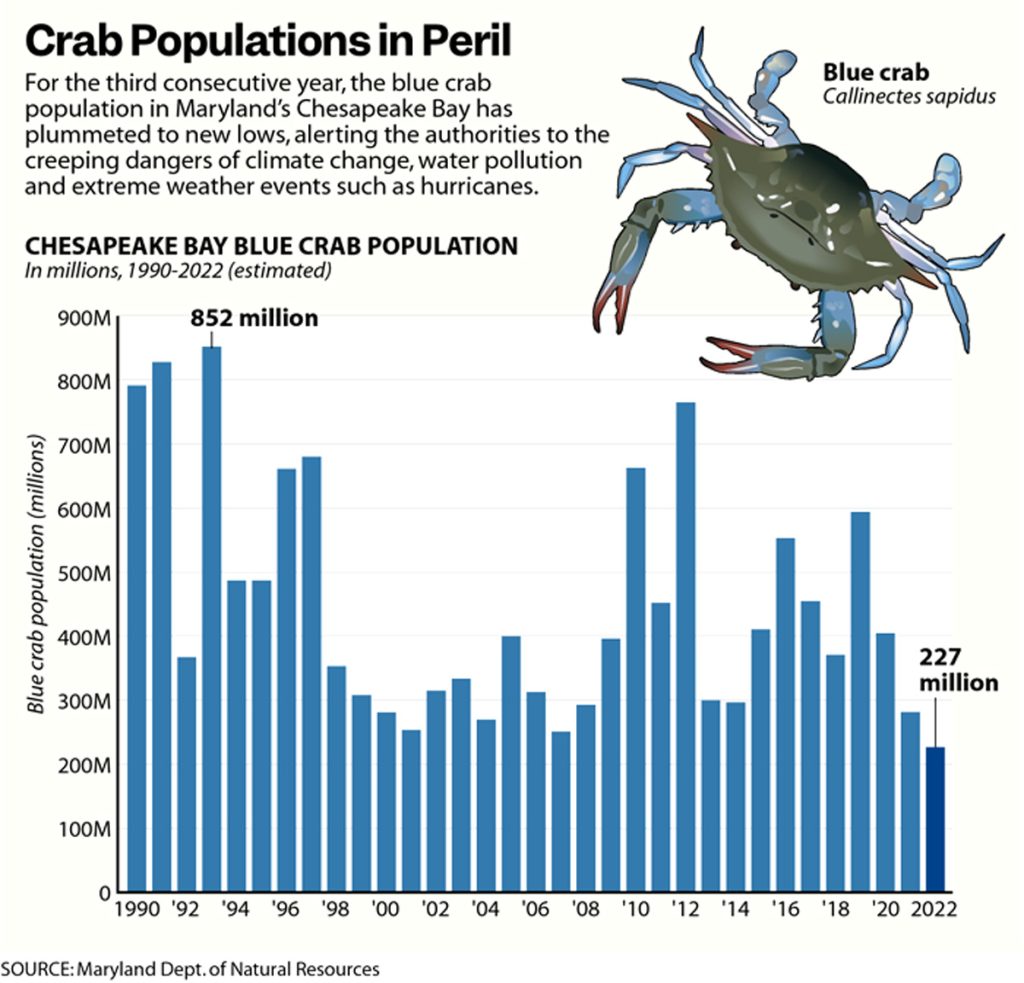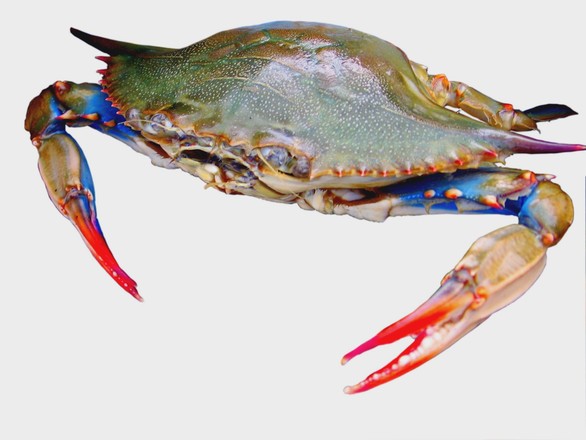One of the most important harvests in the Chesapeake Bay right up there with oysters is the blue crab harvest. Watermen depend on it, the blue crab being in the bay is an important part of the ecology and most of all crabs are an extremely popular and traditional food consumed by visitors and natives alike. The rich and the famous, the poor and infamous and just good old regular folks have been enjoying blue crabs since well before the time of the explorer John Smith who may very well have dined on blue crabs with the not-so-fair maiden Pocahontas. Recent archaeological digs at Mount Vernon, home of George Washington, have revealed that an enormous number of blue crabs were eaten there and most portably was a favorite of our first president.

Native Americans were probably as fond of blue crabs as they were of oysters which ancient oyster mounds proved they consumed in enormous quantities. The harvests have been for the most part consistent over the years but in the last three or four years there is evidence that the honeymoon may be over. In what is called the Winter Dredge Survey it was reported that “the Survey results show that there was a persistent and substantial decline in the spawning stock, recruitment, larval abundance, and female size of blue crabs in the Chesapeake Bay between 1992 and 2007. However, management actions initiated in 2008—including a blue crab spawning sanctuary and harvest restrictions—helped the Bay’s blue crab population rebound toward a healthy, sustainable level.”
The Chesapeake Bay program report, “This year’s Blue Crab Winter Dredge Survey, which is conducted annually by the Maryland Dept of Natural Resources and the Virginia Institute of Marine, brought bad news: The Chesapeake Bay’s blue crab population dropped for the third year in a row. The number of blue crabs—227 million—is the lowest recorded since the Winter Dredge Survey started 33 years ago. While juvenile abundance—the number of young crabs that will enter the fishery this year—increased slightly, the number was still the second lowest in Winter Dredge Survey history. Chesapeake Bay Foundation Senior Regional Ecosystem Scientist Chris Moore issued this statement: “The results of this year’s survey continue a worrying trend for blue crabs in the Chesapeake Bay region. The continued low abundance of juveniles and adult males indicates the urgent need for action to protect these segments of the population.” He said “Although juvenile population estimates can vary greatly from year to year, the 2022 results are the third year of below-average numbers in this segment of the population. These reduced abundances highlight the need to continue to protect adult females to help ensure better numbers in the future.

The survey this year is no better experts point to the loss of grasses, poor water quality and the invasion of the predatory catfish. The report stated. “Fisheries regulators and scientists must work quickly to identify the key ecosystem factors influencing blue crab recruitment and survival so that they can be mitigated to ensure a healthy blue crab population in the future.”
Dr. Dave Eggleston of the University of North Carolina (NCU) is a professor of marine sciences and has a passionate interest in the Chesapeake Bay. Concerned by the indications of a declining blue crab harvest in the bay, he joined together with other researchers and a seafood distributor to obtain funding from the National Oceanic and Atmospheric Associating (NOAA) to conduct research into the feasibility of creating blue crab aquaculture. That is growing crabs on a farm.
There is a serious concern among experts that the crab population in the Chesapeake Bay will no longer be sustainable. This would be catastrophic because it would mean an end to the vital supply to consumers, the livelihood of watermen and the economy of the area. To combat this growing threat a group of experts from various sides of the blue crab issue joined together to study the feasibility of growing blue crabs in an aquiculture environment similar to the salmon fishery. The associated press reported that a Sea Grant of $340,000 from the National Oceanic and Atmosphere Administration (NOAA) had been awarded to study the feasibility. The grant was shared by the University of South Mississippi, North Carolina State University Center for Marine Sciences and Sam Thomas of Thomas Seafood owner of Thomas Seafood in Beaufort, N.C. Dr. Dave Eggleston who is the director of North Carolina State’s Center for Marine Science and Technology and a professor of marine, earth, and atmospheric sciences came up with an idea that seemed to be a win-win situation for the crabs and the farmers looking to diversify their crops using irrigation ponds already existing on their farms to grow blue crabs. Dr. Eggleston is quoted in a press release from NCU “We started by catching small crabs in the wild and stocking them into farm ponds loaded with bass and bluegill predators and were still able to get 12 percent survival.” That worked out very well, and Dr. Eggleston moved on to the next step, which was to team up with a group that had the expertise to grow hatchery-reared blue crabs in fresh water. He enlisted the expertise of the University of Maryland’s Center of Marine Biotechnology. Blue crabs were introduced into the freshwater of the experimental aquaculture ponds at NC State’s Vernon James Research and Extension Center in Plymouth, N.C., where the crabs exhibited some of the highest growth rates on record.
The results were very encouraging, which prompted Dr. Eggleston to try an even larger experiment. He had discovered that a lot of farmers in Eastern North Carolina who had been dependent on declining demand for tobacco were eager to diversify their crop offerings. Dr. Eggleston said, “A lot of these farms have irrigation ponds, and we thought if crabs can live in freshwater, this would take some pressure off the coastal crab population and give farmers another crop, by letting their ponds work for them.” The researchers discovered that those crabs could tolerate a salinity level of only .3 parts per thousand, which is about the same level found in coastal tap water. They did a large-scale test when they stocked a 10-acre lake with 40,000 hatchery-raised crabs and a smaller pond with 4,000 crabs. The crabs will take approximately 105 days to reach maturity. As of this writing, the test was proving very successful.
The next step was to join Sam Thomas of Thomas Seafood in Beaufort NC and create a freshwater pond specially designed for the farming of blue crabs. Mr. Thomas is a veteran member of the blue crab industry and brings to the group his years of experience dealing with the commercial side of the blue crab industry. All the parties involved are optimistic that the hurdles can be overcome and that farming of blue crabs and soft shells can proceed and flourish. Only time and experimentation will tell how it all works out. However, the indications are good that one day the supply of blue crabs will be implemented by farm-grown blue crabs in commercially practical quantities. Check out YouTube video:
https://vimeo.com/812876873/d963a4d388
It makes perfect sense to develop Blue Crab Aquaculture at a time when the warning signs suggest that conditions could very easily turn from bad to worse and the harvesting of blue crabs might have to be curtailed or halted entirely. The efforts of the researchers are not to eliminate the watermen but more to reinforce their future which at this point is very much in jeopardy. And perhaps one day help restore the blue crab population of the Chesapeake Bay to the abundance it enjoyed during George Washington’s time.
